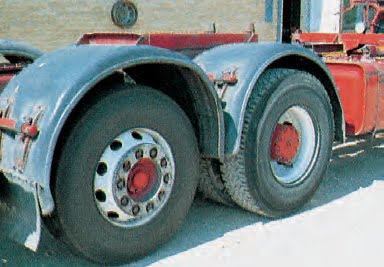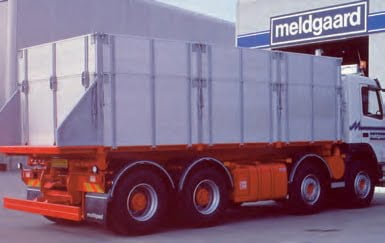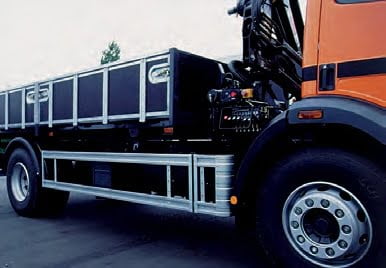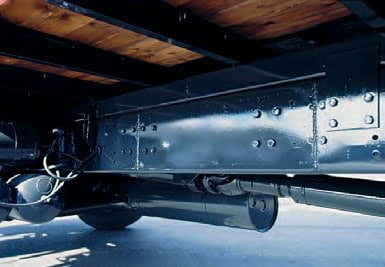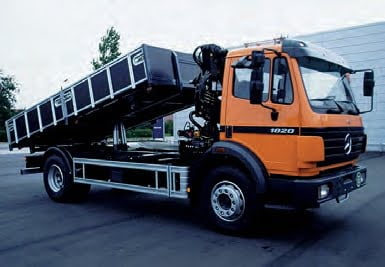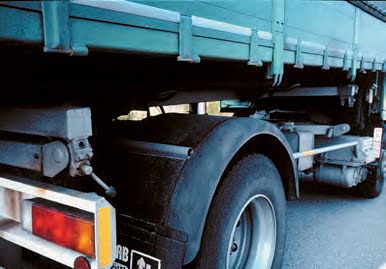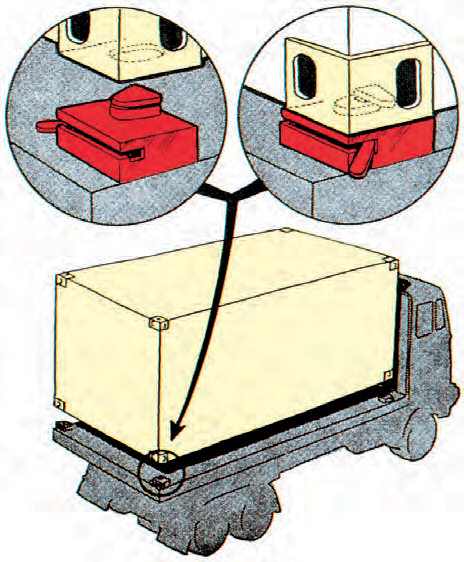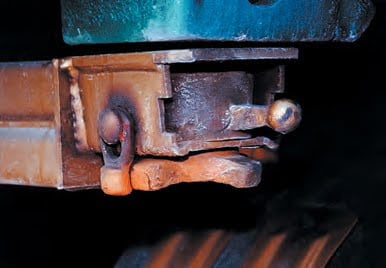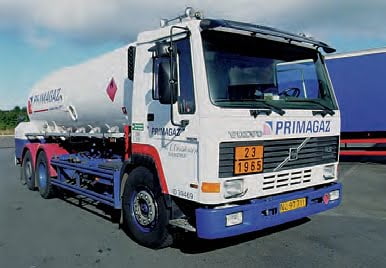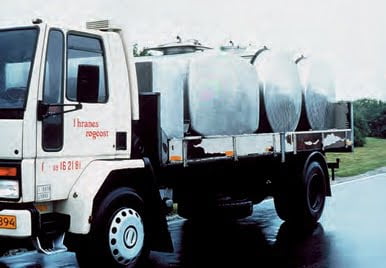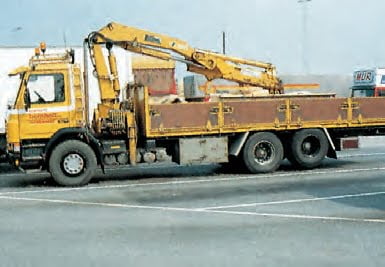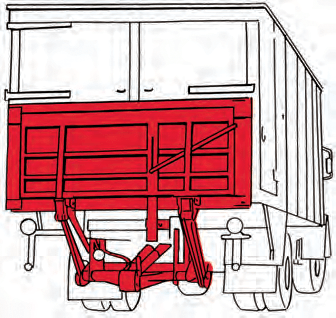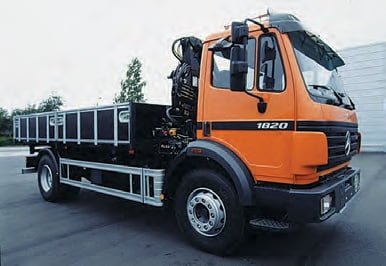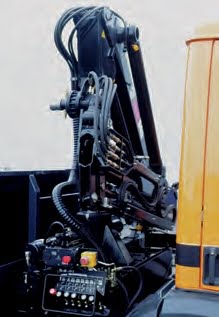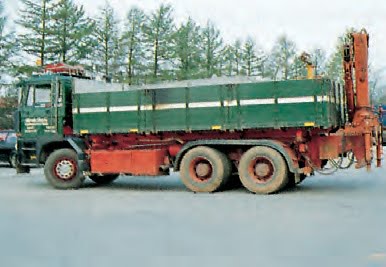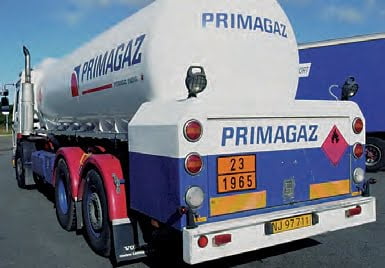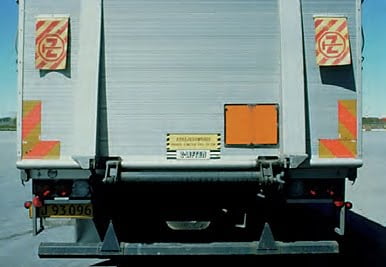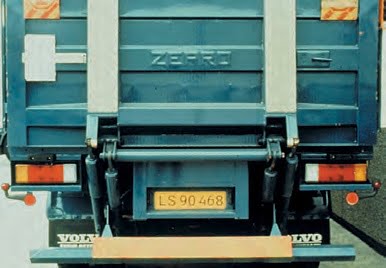large cars
Driving school
theory book
for category C - D - C/E - D/E
Large cars and lorries
7. Bodywork and structure.
The bodywork includes the cab (roof, sides, doors), bonnet and mudguards, as well as the vehicle floor with cargo bed or cargo box. The superstructure includes everything that is placed or mounted on top of the chassis frame (e.g. body, tank, crane, etc.). The lorry can be equipped with several different bodies.
Some cars don't have an actual chassis frame, but may be built as a self-supporting structure (e.g. some buses and smaller enclosed lorries).
A self-supporting body can only have limited build-up.
Legal regulations on bodywork and construction
- The body and superstructure must be firmly attached to the vehicle's load-bearing parts and the superstructure must be firmly attached to the vehicle.
- The bodywork and structure must be free of sharp edges or protruding parts that may cause undue danger to other road users.
- The vehicle's wheels must be shielded, possibly by bodywork design, in such a way that other road users are protected from splashes.
You should check the following conditions:
- That any tiltable cab is locked in accordance with the manufacturer's instructions.
- Doors to any cargo compartment are securely closed/secured (for bus boot lid).
- That any container or swap body is securely fastened.
- That any tarpaulin is tightened.
- That any goods are placed and secured securely.
- Lorries must be equipped with a rear bumper at the rear to prevent people from driving underneath the vehicle. Special rules apply for vehicles with swap bodies, for example.
- Trucks should normally be equipped with side guards on the right-hand side.
- Tipper trailers, tail lifts, loading cranes and swap bodies must undergo a statutory general inspection at least every 12 months by a supplier or an authorised expert in accordance with the supplier's instructions.
Commonly occurring structure
Fixed loads are attached with bolts to the chassis frame or a subframe that distributes the load on the chassis frame. Bolts must be tight and the chassis and subframe must be free from cracks or breaks.
A tipper body is a body that can be tipped backwards or sideways using a hydraulic lifting system (pump and lifting cylinder). The lifting system must be firmly integrated into the chassis frame and designed in such a way that tipping automatically stops when the body is in the upper position. The body must also be mechanically supported in any position when working underneath it.
When driving, the tipper must be held in the transport position with locks.
A container is a cargo space that is intended to be loaded or unloaded onto or off a vehicle, with or without cargo. Container bodywork includes container locks in the chassis or subframe so that the container can be securely locked at each corner while travelling.
Container locks.
Swap bodies (swap bodies or swap bodies, including "waste container" and "tank swap body") are types of bodies designed for loading and unloading:
This is a bed designed for loading and unloading, which must be raised on support legs at a suitable height so that the lorry can drive under the bed.
Bodywork for travelling with a swap body (swap body or swap body) includes devices that can securely hold the body on the truck.
Refuelling vehicle
Tanks can be permanently attached to the vehicle or removable. Tanks with a volume of 4 m3 or more when mounted on a trailer must be attached to the chassis or subframe.
Smaller tanks can be removable, but must be attached to the crossbars of the truck bed when travelling.
Risk conditions
Driving with a container, tank or other high structures raises the centre of gravity, changing the driving characteristics and increasing the risk of tipping over when cornering. Under heavy braking, the load (especially liquids) can shift forwards with the risk of unstable braking.
The loading tailgate is a liftable platform for loading and unloading.
When driving, the loading tailgate must not be used as an extended load, but must be folded up in the correct transport position according to the manufacturer's instructions.
A loading crane is an auxiliary tool for loading and unloading. Truck-mounted loading cranes must be securely mounted to the vehicle either between the cab and bed or behind the bed.
When travelling, the loader crane must be placed in the correct, secured transport position according to the manufacturer's instructions. Special training and licences are required to operate larger loader cranes. This also applies to the operation of mobile cranes.
Risk conditions
The loading crane mounted behind the load shifts the vehicle's centre of gravity backwards, which, especially when driving without a load, makes the vehicle less directionally stable and prone to oversteer. The same risk can be present when driving a loaded truck where the load (load centre) is positioned further back than normal (this risk is especially present when driving with a swap body). Trucks with a bogie construction and rear-mounted loading crane must not have a raised rear axle when travelling on the road.
Transport of dangerous goods
- Trucks transporting dangerous goods in tanks and certain trucks transporting explosive substances must be specially authorised by an inspection company and the Danish Emergency Management Agency. The driver must be in possession of an ADR certificate.
Test your knowledge
Cat. C - D - C/E - D/E - D/E - Section 7
Select the questions you think are the right ones.
